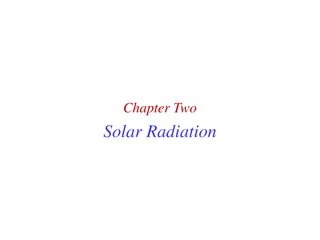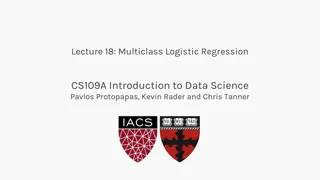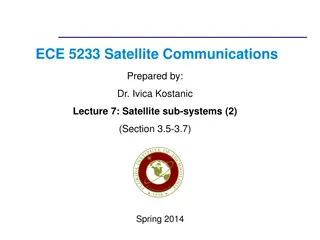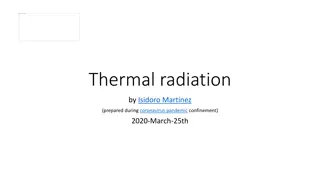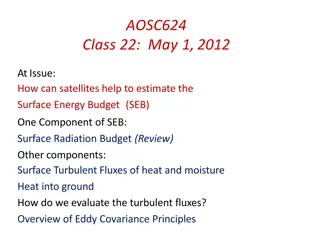Estimation of Surface Solar Radiation in Malang Using Satellite Data Regression
Surface solar radiation estimation in Malang is conducted using IR1 channel satellite data regression. This study aims to fill the gap in radiation observation data by utilizing cloud top temperature measurements from IR imagery. The methodology involves determining radiation values based on atmospheric radiation equations and cloud top temperature data. The regression equation is constructed to validate estimated radiation values against pyranometer data, with validation parameters such as mean absolute error considered. The results reveal annual and monthly correlations between observed radiation and binary data, showcasing promising outcomes for further research and applications.
Download Presentation

Please find below an Image/Link to download the presentation.
The content on the website is provided AS IS for your information and personal use only. It may not be sold, licensed, or shared on other websites without obtaining consent from the author. Download presentation by click this link. If you encounter any issues during the download, it is possible that the publisher has removed the file from their server.
E N D
Presentation Transcript
SURFACE SOLAR RADIATION ESTIMATION IN MALANG SURFACE SOLAR RADIATION ESTIMATION IN MALANG USING IR1 CHANNEL SATELLITE DATA REGRESSION USING IR1 CHANNEL SATELLITE DATA REGRESSION Rikha Rizki Mahmudiah, Andang Kurniawan, and Munawar Indonesian State College of Meteorology Climatology and Geophysics, Perhubungan Street 5, Pondok Aren, South Tangerang, 15221, Indonesia
Introduction Need of surface radiation data (??) which is affected by radiation at the top of the atmosphere (??). Radiation observation data is not yet available at each point. Infrared Channel is a standard channel for cloud observation. IR imagery allows measurement of cloud top temperature (CTT) and earth surface temperature.
Area of Study Malang Climatology Station 112.5978 East 7.9011 S 588 meters above sea level
Data 1. Cloud Top Temperature (CTT) per hour from IR1 channel satellite Weather Kochi page. 5/365 days couldn t be processed due to the unavailability of satellite data. One hour empty data is filled with the average of the hours before and after it. 2. Total daily radiation data at Malang Climatology Station (112.5978 E 7.9011 S) in 2015 obtained from CMP3 pyranometer and corrected gun bellani.
Method Estimated radiation value can be determined based on radiation data from the Top of Atmospheric Radiation (ToAR) equation and the cloud top temperature from the IR1 satellite. ToAR is affected by sun declination angle and aphelion-perihelion point which magnitude is experiencing daily variation. ???= (0,75 + 2.10 5?)??
Constructing input data for the regression equation. Both treatments are made in monthly and annual time dimensions Data Type Treatment BINER CTT x (1, if there is radiation, and 0, if there is no radiation) CTT x ??? RAD Best x data construction is determined by the greatest ??? from the radiation data from the pyranometer with RAD and BINER. Estimated ?? value from the equation obtained and validated with pyranometerdata. Validation parameters : mean absolute error (MAE)
Result and Discussion Annual observation: RAD (0.72) and BINER (0.70). data correlation to Monthly data correlation to observation: RAD (0.71) and BINER (0.67). No significant difference. The x data to input the model is better to use RAD data. Figure 1. Correlation of BINER and RAD to observation data
Figure 2. Estimated MAE Best model based on MAE is obtained from monthly RAD data
Figure 3.A and B coefficients of regression equation of annual and monthly data The coefficient of annual data provides values that are more common at all times. RAD data is better than the others, so the coefficients A and B is needed every month in order to form a regression equation.
3000 2500 Y = Ax + B Estimation (J cm-2) 2000 x : CTT data multiplied by Ra 1500 1000 The scatter plot shows a relatively collected pattern of estimation and observation results 500 0 0 500 1000 Observation (J cm-2) FEB MAR AUG SEP 1500 2000 2500 3000 JAN JUL APR OCT MAY NOV JUN DEC Figure 4.Scatter plot of estimation result with monthly data regression equation
Conclusions 1. Cloud Top Temperature (CTT) data from the IR1 channel satellite can be used to estimate the surface radiation value through the regression equation. 2. Combination of CTT data with surface radiation calculations in clear sky conditions is recommended to be used as data for radiation estimation. 3. Further studies are still needed regarding the possibility of using other channels as well as other better regression methods.










